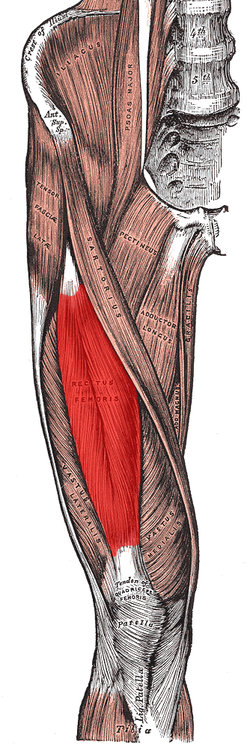Rectus Femoris
Description[edit | edit source]
Rectus femoris is a bulk of muscle located in the superior, anterior middle compartment of the thigh and is the only muscle in the quadriceps group that crosses the hip[1].
It is superior and overlying of the vastus intermedius muscle and superior-medial part of Vastus lateralis and Vastus medialis.
The word rectus is a latin word connoting “straight”. Thus the rectus femoris received its name because it runs straight down the thigh[2].
It is a two way acting muscle as it crosses over the hip and knee joint; therefore, it contributes to 90° of knee flexion and assists iliopsoas in hip flexion[3][1].
A short rectus femoris may contribute to a higher positioned patella in relation to the contralateral side. A markedly shortened rectus femoris is suggested by knee flexion of less than 80°or by marked prominence of superior patellar groove[4]
Anatomy[edit | edit source]
Origin[edit | edit source]
Rectus Femoris originates from anterior inferior iliac spine(AIIS) and the part of alar of ilium superior to the acetabulum[1]
Insertion[edit | edit source]
Rectus Femoris together with vastus medialis, vastus lateralis and vastus intermedius joins the quadriceps tendon to insert at the patella and tibial tuberosity (via patellar ligament)[4].
Nerve supply[edit | edit source]
Rectus Femoris is innervated by the femoral nerve, originating from lumbar nerve 2, 3, and 4 nerve roots
Bloody supply[edit | edit source]
Blood is supplied to the Rectus Femoris via descending branch of the lateral circumflex femoral (LCF) artery.
Function[edit | edit source]
Actions[edit | edit source]
- Hip flexion
- Rectus Femoris acts with iliopsoas to produce hip flexion especially if the knee is flexed[2].
- During gait, as a hip flexor, it acts with the iliopsoas in "Toe off" phase,.
2. Knee extension
- Together with other muscles that are part of the Quadriceps femoris, it facilitates knee extension.
- In terminal swing phase rectus femoris acts as an extensor of the knee, as a muscle in the quadriceps group, it generate force needed for loading(foot flat phase) in stance phase[5].
- Rectus femoris is more efficient in movement combining hip hyper-extension and knee flexion or from a position of knee extension and hip flexion. For example kicking a soccer ball[2][3]
Assessment[edit | edit source]
Power[6][edit | edit source]
The power test for the Rectus Femoris muscle is done in sitting with the hip and knee flexed to 90° for grade 5, 4 and 3 while for grade 2, it is done in Side-lying with test limb uppermost and knee flexed to 90° position.
The therapist is situated at the side of the leg to be tested with the patient in supine lying, one hand placed under the knee of the lower limb being tested, and the other hand wrapped around the leg superior to the ankle given a downwards pressure at the direction of the flexed knee. The patient is asked to extend the knee against resistance.
Grade 5 is given if the patient is able to extend and maintain position at end range against maximal resistance.
Grade 4 is given if the patient is able to extend and maintain position at end range against moderate resistance.
Grade 3 is given if the patient is able to extend and maintain position at end range against no resistance except gravity.
The therapist stands behind the patient lying sideways with the limb being tested uppermost and flexed to 90°, one hand is place immediately superior to the malleoli while the other hand is placed at the underside of the thigh proximal to the knee. The patient is asked to straighten the limb.
Grade 2 is given if the patient is able to extend the knee and maintain position at end range.
For grade 1 and 0, the starting position is the same for grade 3 assessment but the hand placement of the therapist changes; one hand is placed under the knee while the other hand is placed at anterior part of the thigh immediately above the knee for easy palpation of the quadriceps and patella tendon. The patient is asked to push down the knee towards the therapist's hand and the plinth.
Grade 1 is given if therapist is able to feel contraction of the muscle and grade 0 is given if no contraction is palpable.
Other Test[7][edit | edit source]
In Rectus femoris injury :
- FABER (Patrick's test) illicit no pain
- Pain is felt in resisted hip flexion[8]
- Ely’ test illicit pain on tightness
- Knee ROM is reduced below 80° in shortness of Rectus femoris or prominence of patella grove is noted.
Resources[9][edit | edit source]
[10]
References[edit | edit source]
|







